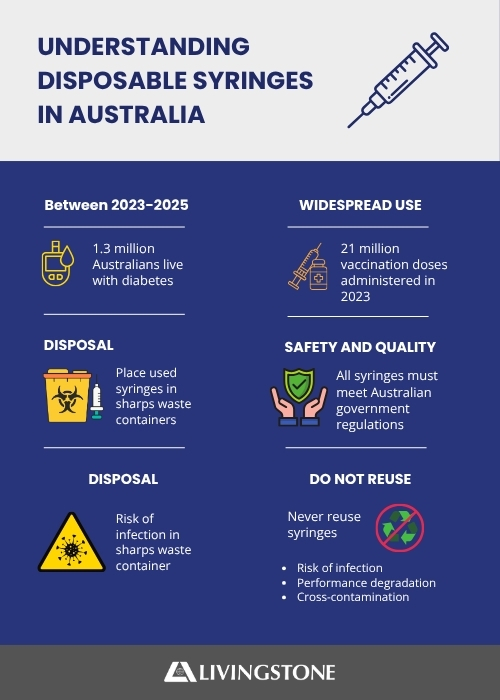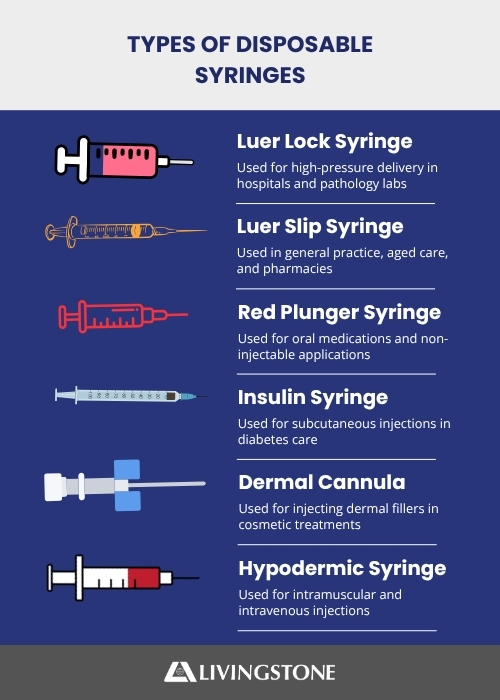Disposable syringes play a vital role in Australia’s healthcare and laboratory settings. Whether delivering vaccinations, administering medication, drawing blood, or irrigating wounds, syringes are indispensable across hospitals, clinics, pharmacies, aged care, veterinary practices, and even in home settings.

Between 2023 and 2025, syringe usage in Australia has remained consistently high. The Australian Institute of Health and Welfare (AIHW) reported over 21 million vaccination doses administered in 2023 alone, with millions more syringes used for chronic disease management, diagnostic testing, and outpatient care. Demand is further driven by the increasing prevalence of diabetes, which affects 1.3 million Australians, and ongoing public health efforts related to infection prevention and emergency preparedness.
These trends highlight the importance of safe, single-use devices that support both patient care and public safety. Understanding the different types of syringes, how they are regulated, and the correct methods of disposal helps individuals and organisations make informed choices about their use. This guide covers the key considerations around disposable syringes in Australia.
Types of Disposable Syringes
Luer Lock Syringes
Luer lock syringes have a threaded tip that allows the needle to twist and lock securely into place. This design prevents accidental detachment and is ideal for procedures involving high-pressure delivery, such as intravenous medication or aspirating viscous fluids. These are widely used in hospitals, surgical theatres, and pathology labs.

Luer Slip Syringes
Luer slip syringes offer a friction-fit connection, allowing the needle to be pushed on and pulled off easily. They are quicker to assemble and are suitable for low-pressure applications, including intramuscular injections or flushing catheters. Their convenience makes them common in general practice, aged care, and pharmacy settings.
Red Plunger Syringes
Red plunger syringes are colour-coded for visual identification. They are often used for oral medications or specific non-injectable applications, helping reduce the risk of medication errors. This feature is especially useful in paediatrics, aged care, and veterinary use, where clear product differentiation is critical.
Insulin Syringes
Insulin syringes are designed for self-administered subcutaneous injections and are calibrated in insulin units for dosing accuracy. They are small in volume, typically ranging from 0.3 mL to 1 mL, and feature ultra-fine needles to minimise discomfort. With over 1.3 million Australians living with diabetes, insulin syringes are an essential part of daily life for many patients.
Dermal Cannulas
Dermal cannulas are used in cosmetic medicine to inject dermal fillers. Unlike traditional needles, they have a flexible blunt tip that reduces tissue trauma and minimises bruising. They come in various lengths and gauges and must be matched to both the treatment area and the type of filler used. Clinics often refer to the ACAM Protocol for Supervised Delegated Injectors to ensure safety and compliance.
Hypodermic Syringes
Hypodermic syringes are standard for injections beneath the skin and are commonly used for intramuscular, subcutaneous, and intravenous applications. When paired with a hypodermic needle, they provide reliable, sterile delivery of medications, vaccines, or samples.
Safety and Regulation in Australia
All disposable syringes sold in Australia are regulated as medical devices under the Therapeutic Goods Act 1989. They must comply with rigorous standards for sterility, durability, and biocompatibility. The Australian Register of Therapeutic Goods (ARTG) lists approved syringes that have undergone quality and safety assessment.
These regulations help prevent adverse health outcomes such as contamination, breakage during use, or unsafe injection practices. Products from reputable suppliers often exceed the minimum requirements and are manufactured in ISO-certified facilities. When selecting syringes, especially in clinical or laboratory environments, it is essential to choose ARTG-listed products with transparent compliance documentation.
Why Syringes Should Never Be Reused
Although disposable syringes may appear intact after use, they are not designed for multiple applications. Even with the same patient, reusing a syringe increases the risk of infection, degradation of performance, and cross-contamination. Microscopic residue and weakened seals can compromise sterility and deliver inaccurate doses.
Australia’s National Infection Prevention and Control Guidelines emphasise that all syringes and needles should be discarded immediately after use. Unsafe reuse has been linked to serious consequences globally, including the spread of bloodborne viruses such as hepatitis B and C. According to the World Health Organization, safe injection practices are a cornerstone of patient safety, particularly in high-frequency care settings.
Correct Disposal of Used Syringes
Safe disposal of used syringes is critical for preventing injury and protecting public health. Whether used in a hospital, general practice, pharmacy, or home, sharps waste must be handled with care. All used syringes should be placed immediately into a sharps container, a rigid, puncture-resistant container with a secure lid and clear labelling.
In healthcare environments, these containers are part of regulated clinical waste management systems. For home users, many pharmacies and local councils offer access to sharps bins and return programs. In New South Wales, guidance is provided under the PD2020_049: Clinical and Related Waste Management policy, which outlines responsibilities for safe collection and disposal.
Used syringes should never be disposed of in household rubbish, recycling bins, or flushed down toilets, as this endangers sanitation workers and the community. It is also illegal in most states and territories. Where services are available, drop-off points for sharps containers are the safest and most responsible disposal option.
Disposable syringes are foundational to safe, effective healthcare. Understanding their different types, regulatory safeguards, and correct disposal methods ensures their use aligns with best practice. For clinicians, carers, and individuals alike, taking the time to follow proper syringe handling and waste procedures helps protect everyone involved and contributes to a safer, healthier Australia.
References
- NSW Health, 2020. PD2020_049 Clinical and Related Waste Management for Health Services. [pdf] Sydney: NSW Ministry of Health. Available at: https://www1.health.nsw.gov.au/pds/ActivePDSDocuments/PD2020_049.pdf [Accessed 17 Jul. 2025].
- Australian Institute of Health and Welfare. (2023). Immunisation and Vaccine Uptake. Retrieved from AIHW vaccine uptake report. [Accessed 17 Jul. 2025].
- World Health Organization (WHO), 2022. Injection Safety: Fact Sheet. [pdf] Geneva: World Health Organization. Available at: https://cdn.who.int/media/docs/default-source/integrated-health-services-%28ihs%29/injection-safety/is_fact-sheet.pdf?sfvrsn=27f55c57_5 [Accessed 17 Jul. 2025].
- Australasian College of Aesthetic Medicine (ACAM), 2024. Protocol for Supervised Delegated Injectors: Use of Schedule 4 Medications and Devices. [pdf] Sydney: ACAM. Available at: https://www.acam.org.au/wp-content/uploads/2024/10/ACAM_PROTOCOL_FOR_SUPERVISED_DELEGATED_INJECTORS_USE_OF_SCHEDULE_4_ME.pdf [Accessed 17 Jul. 2025].
